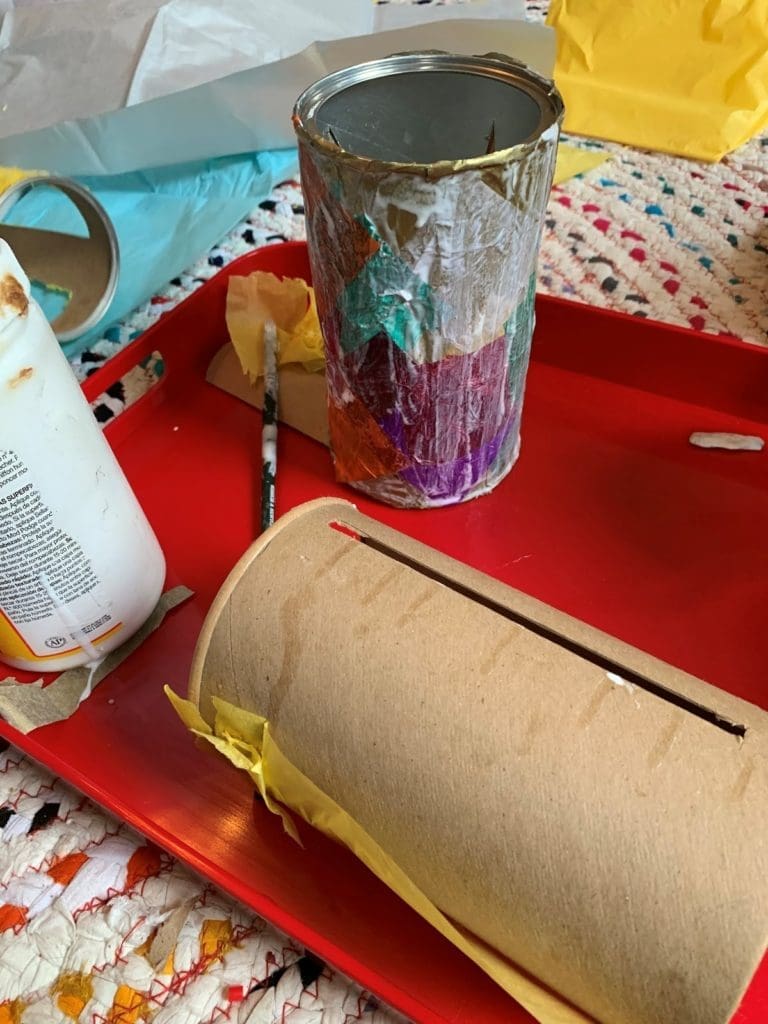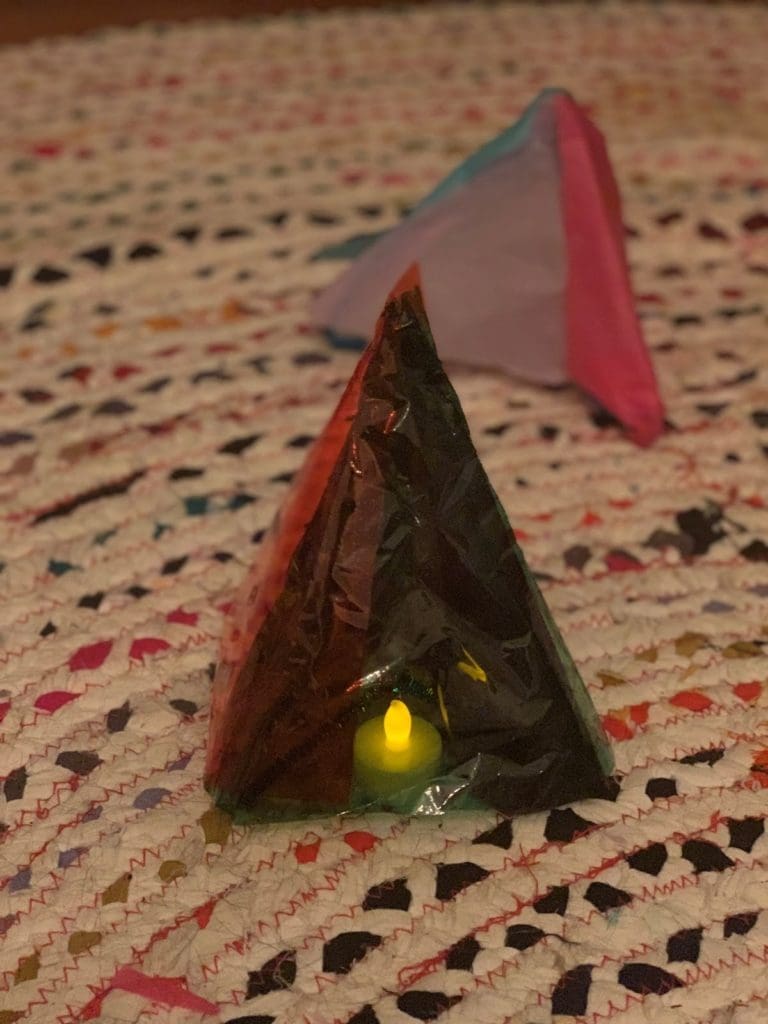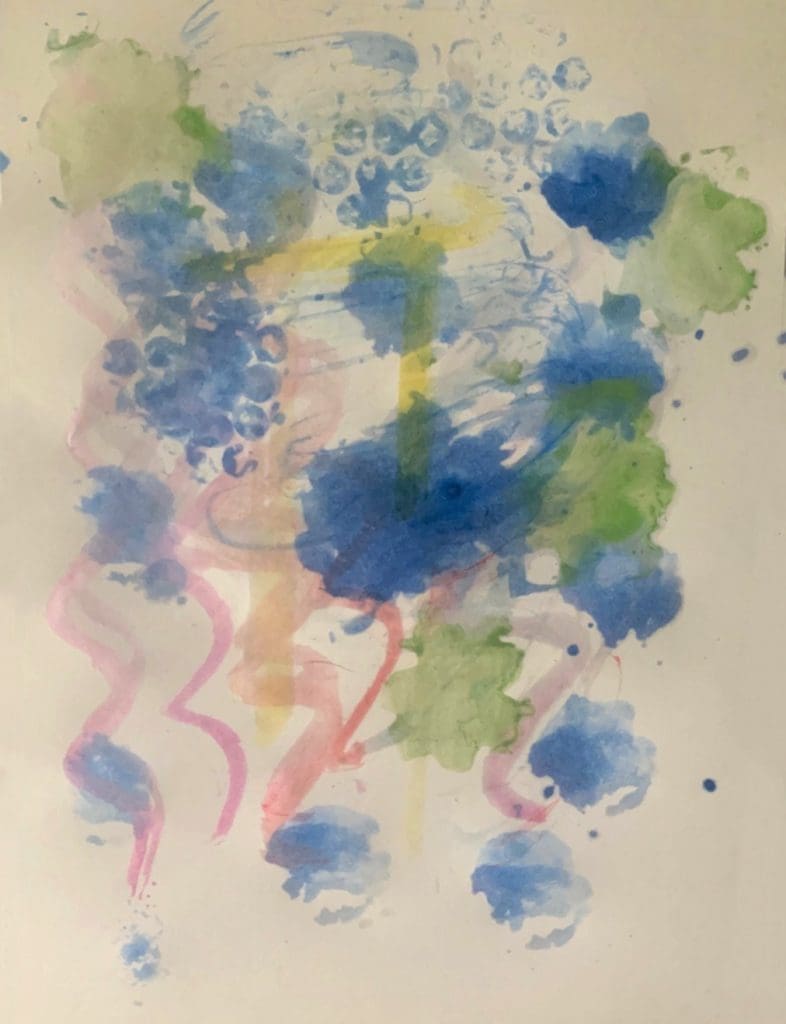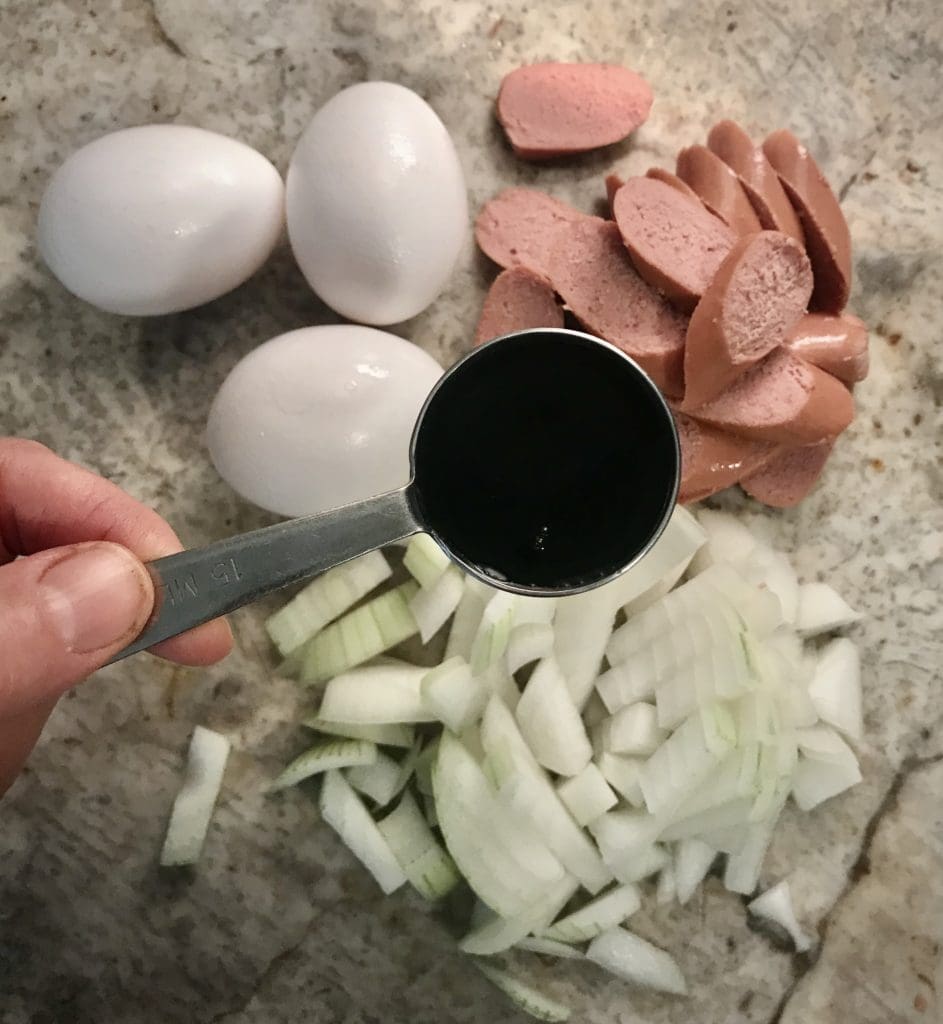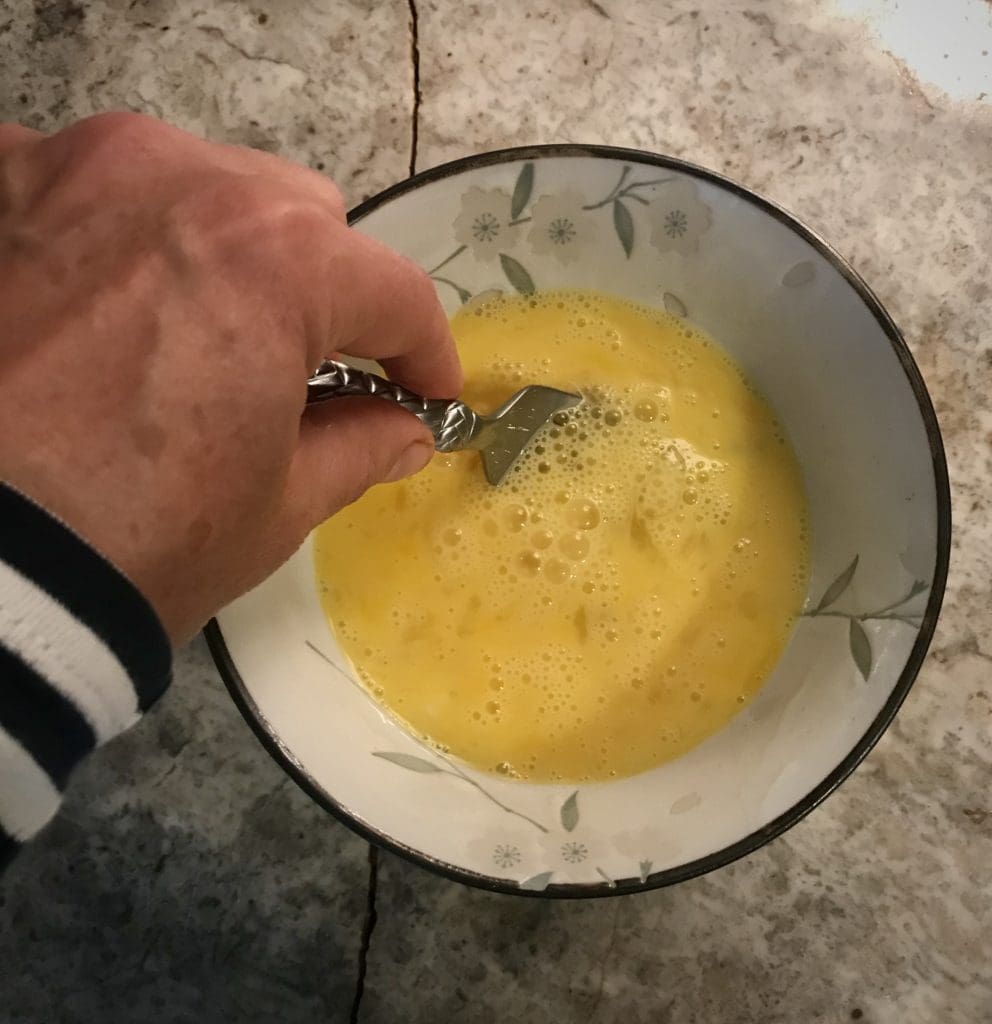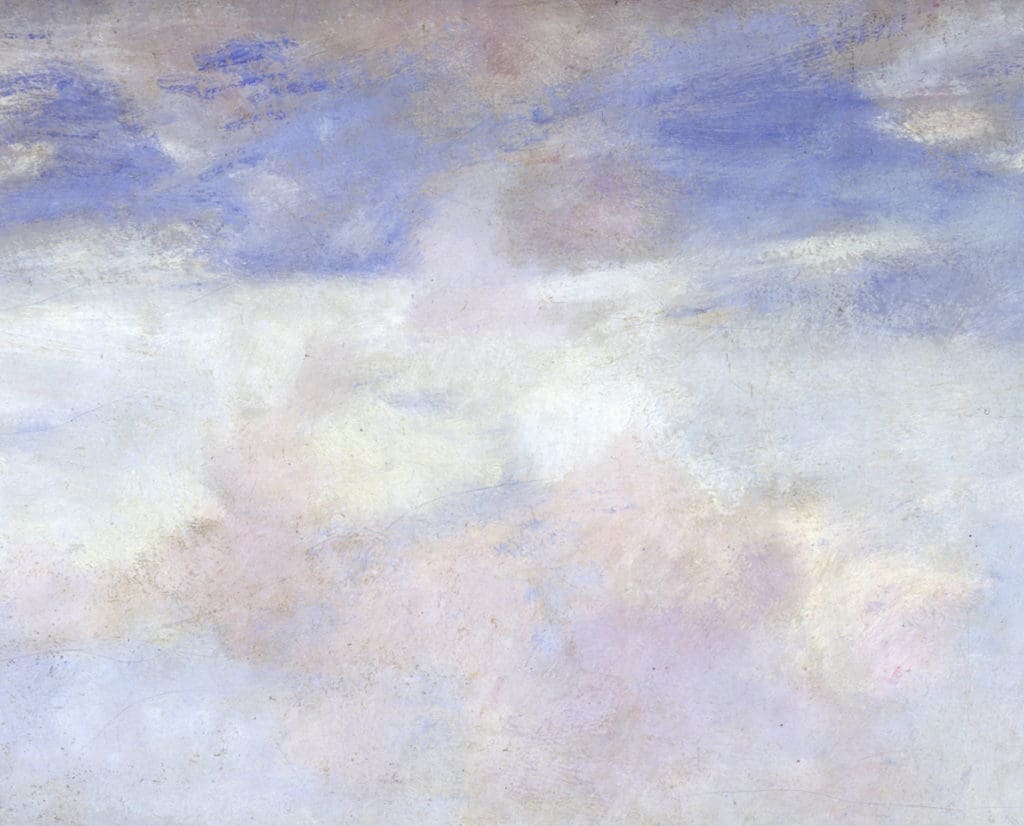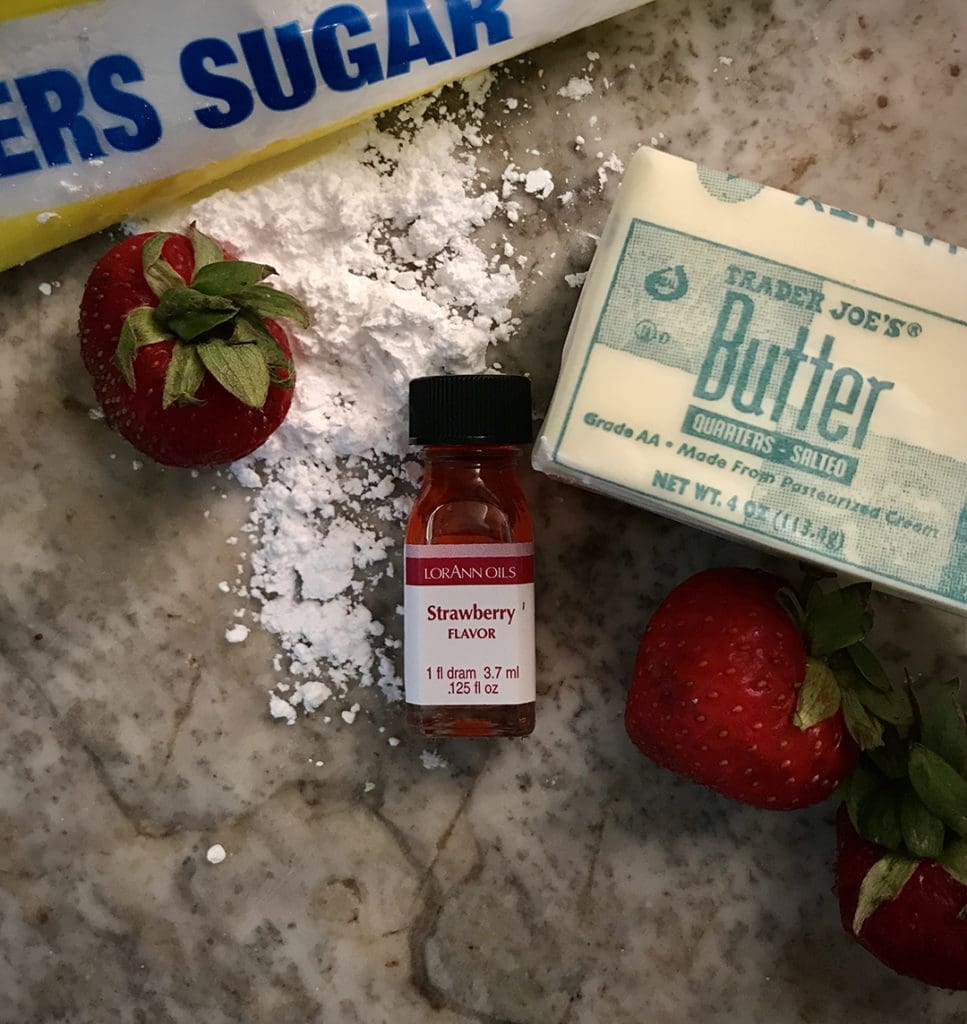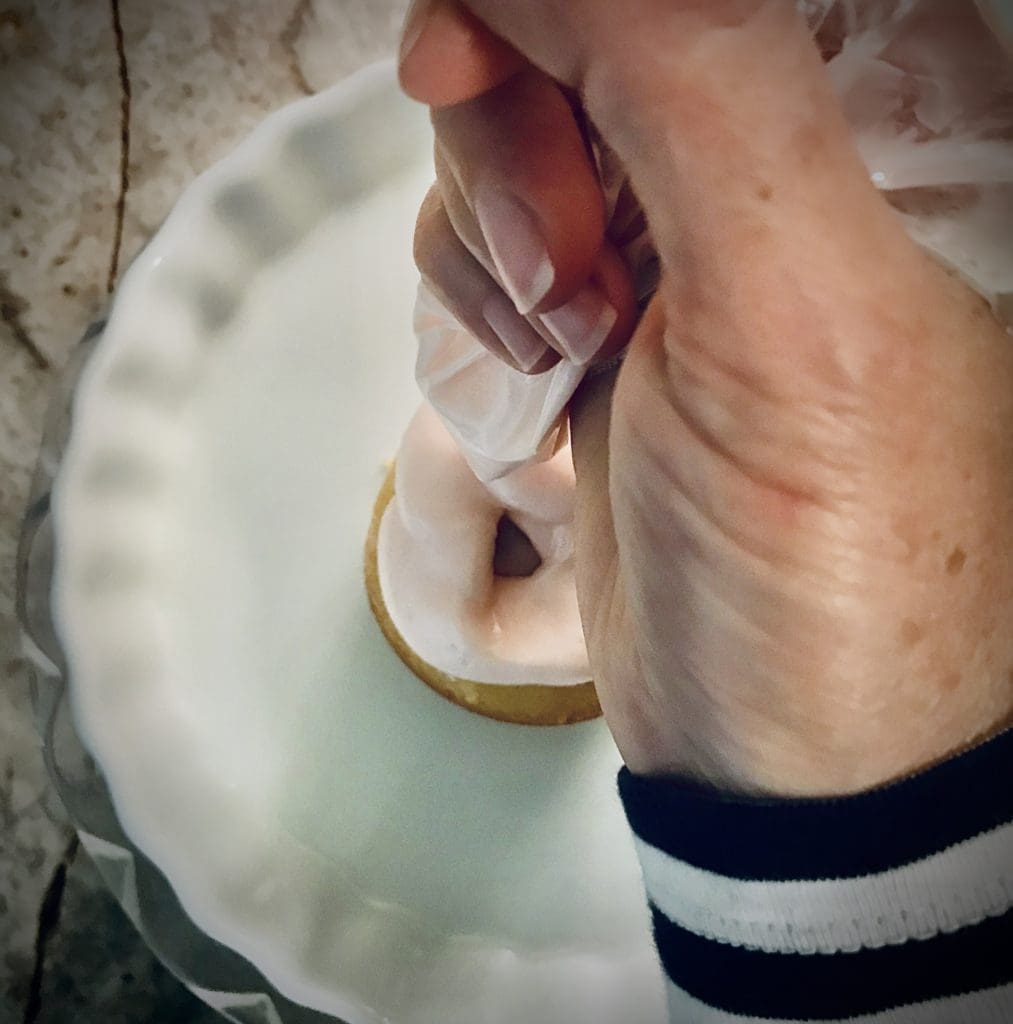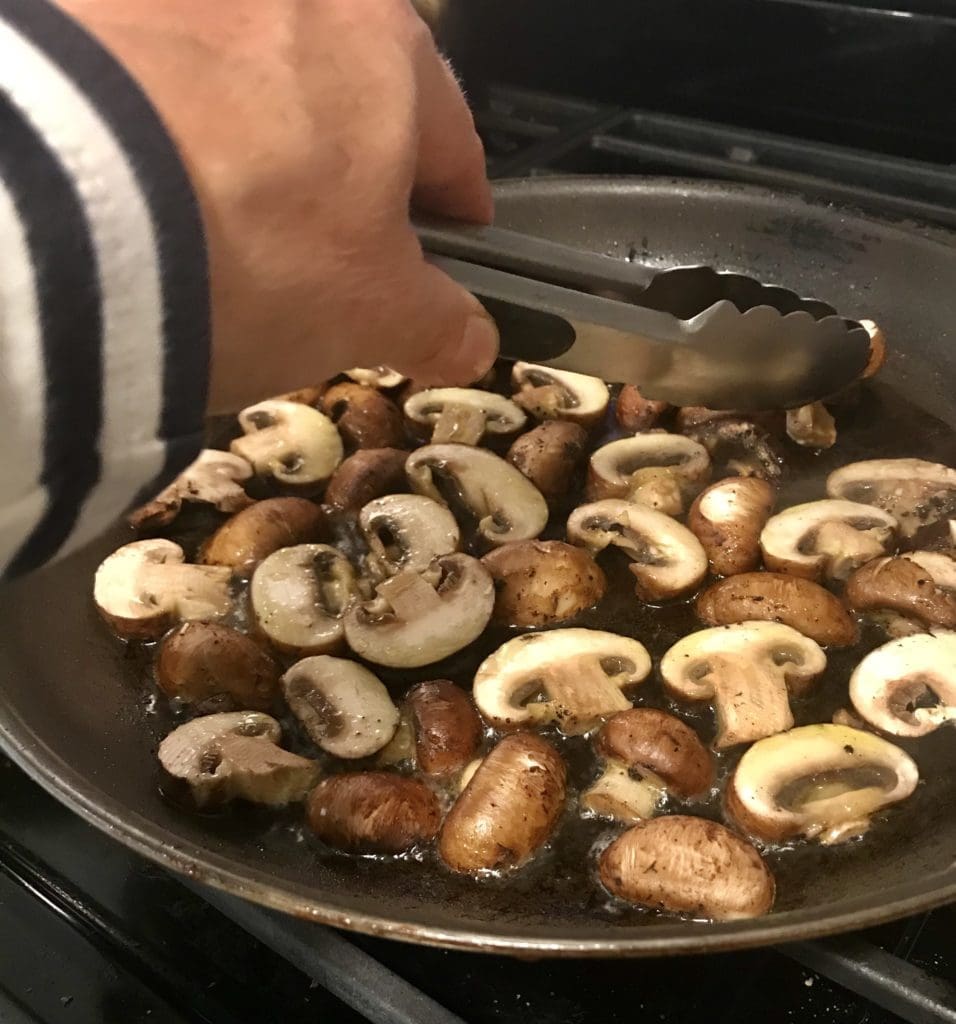Media
Crépuscule : An Ode to Dusk
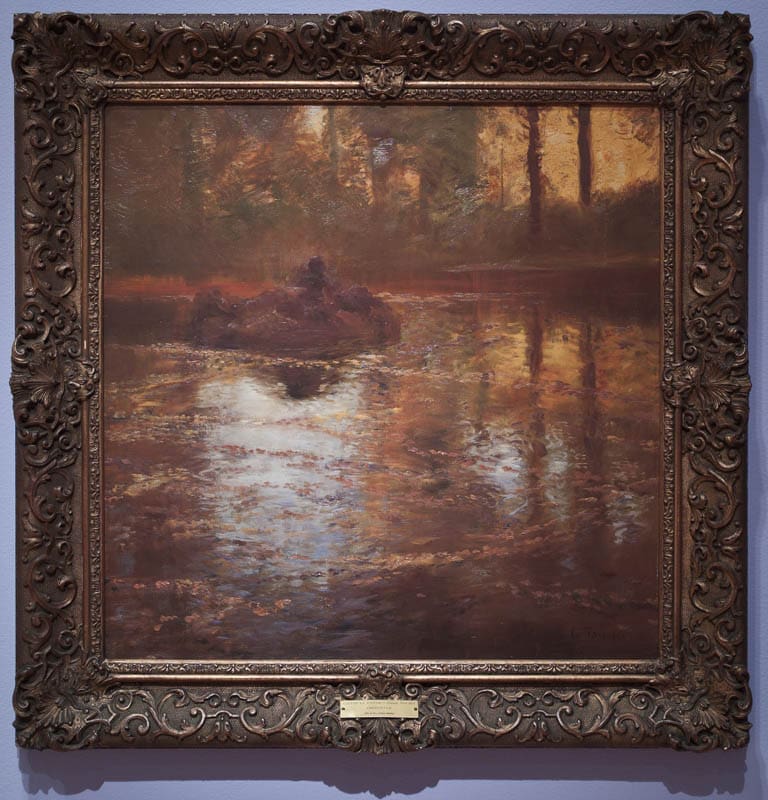
This painting by French artist Gaston La Touche is an ode to dusk (“crépuscule” in French) and its subtle beauty of color and light. Fallen leaves gather in lines to create a dancing pattern across the reflective surface of a pond as a still quiet envelops the surrounding woods.
La Touche displayed an early interest in art and began drawing classes at the age of ten. He spent much of his youth observing French artworks from the 17th and 18th centuries in the picture galleries of palaces in his hometown of Saint-Cloud and nearby Versailles. These experiences informed his later choices of subject matter, as many of his paintings include courtly figures, regal residences, and romantic settings such as the one seen here. This image of a fountain and pond in the dwindling light of sunset likely depicts a scene in the royal gardens of Versailles, one of the artist’s favorite subjects. In his own words: “I only have one Master, the Park of Versailles.”
What mood does this painting communicate? Do you think the artist completed this work outdoors and on location, or in a studio?
Although La Touche may not be well-known to contemporary audiences, he was a prominent member of French painting circles during the second half of the nineteenth century. Renowned artists Félix Bracquemond and Édouard Manet served as mentors to a young La Touche. Later, the painter frequented the same Paris cafés as many influential figures in the Impressionist movement, such as Émile Zola and Edgar Degas. While his work features some Impressionist characteristics, La Touche’s paintings differ in subject matter and brushwork.
Read MoreTo Uncertainty
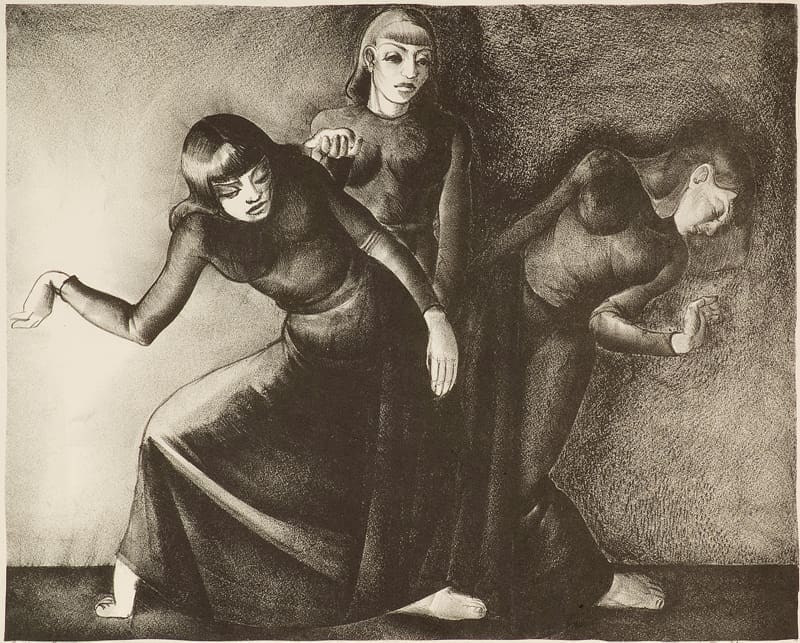
Honoré Guilbeau had early aspirations as a dancer, but soon after enrolling in classes at the Art Institute of Chicago, she shifted her focus to printmaking. Her thoughts were never far from dancing however, and she often featured dancers and theater scenes in her works.
In this print, the three dancers and their movements appear somewhat enigmatic. Their forms seem to emerge from the same core, yet they have separate upper bodies. Or, the figures could all represent the same dancer at different moments in time as she sweeps through her choreography. As a dancer herself, Guilbeau may have been intrigued by the challenge of depicting the movement of dance in the static visual medium of printmaking. The title of the work offers no additional clarity and indeed points to uncertainty itself. Is To Uncertainty an ode to a particular emotion Guilbeau felt at the time? Is it the title of a dance or performance she participated in or saw? Or, is it a comment on the image itself, for which no certain explanation is readily apparent?
What do you think these figures and their movements represent? What do you think that visual artists might gain by participating in other types of art, like dance or theater?
Guilbeau moved to Cleveland in the 1930s where she found work through the Works Progress Administration (WPA) art project, serving as a set and costume designer with the Cleveland Theater for Youth and continuing her work as a printmaker. Guilbeau made this print as part of a series depicting dancers for the WPA art project. Many of her other prints were also included in the “Print-a-Month” series, a subscription service through the Print Makers Club of Cleveland that sent a monthly etching, lithograph, or woodcut to its members. The Akron Art Museum counts a number of these “Print-a-Month” works among its collection, not only from Guilbeau but from other leading Cleveland-area artists as well.
In 1939, Guilbeau and her family moved to a farm in Peninsula, OH, a small town situated between Akron and Clevleand in the Cuyahoga Valley National Park. Guilbeau transformed their barn into an art school for children and helped form the Peninsula Players theater group, for which she also danced, designed sets, and made costumes. From the 1940s on, Guilbeau dedicated her time to numerous activities in the arts and literature. She taught at the Akron Art Institute (now the Akron Art Museum) for several years and later worked as a book illustrator, producing drawings for A Connecticut Yankee in King Arthur’s Court as well as a series of children’s books with Cleveland author Ethel Collier. Guilbeau was also instrumental in establishing the Peninsula Library, where her pebble mosaic Mural of Transportation in the Valley can still be found on the exterior wall just next to the library’s front door.
Read MoreAAM Mad Libs
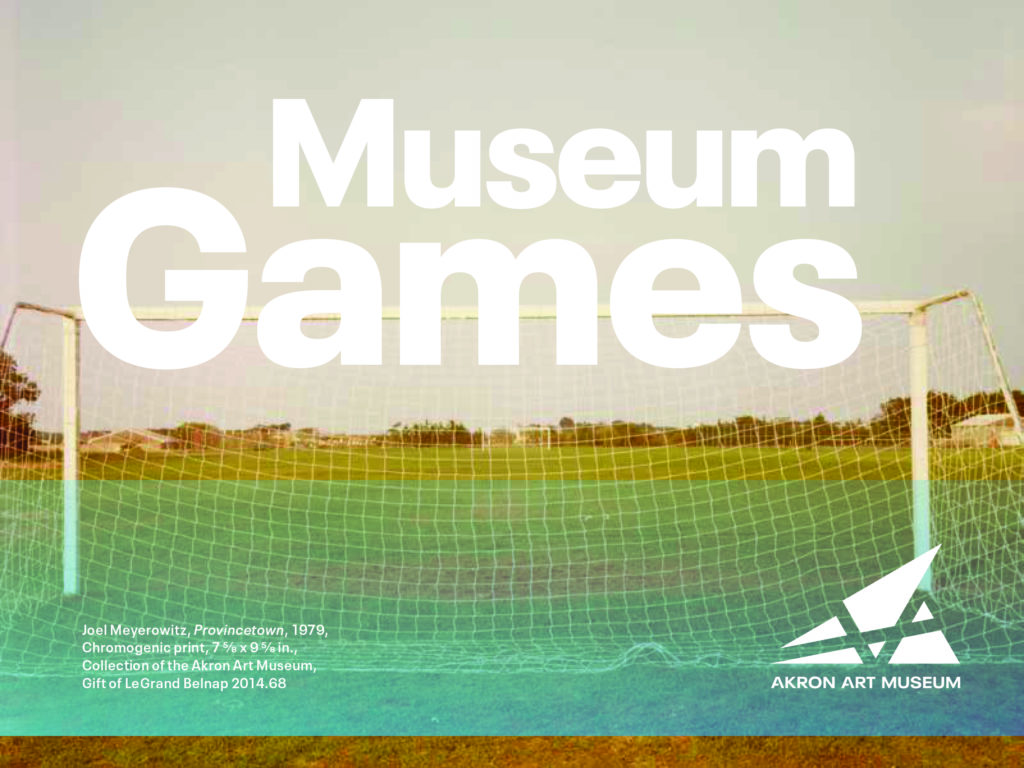
You can play AAM mad libs with your friends or by yourself. Here’s how
to play: Creatively fill in the list on the next page with whatever words you
like, then transfer your list to the blanks in the story. Finally, read the story
from start to finish and enjoy your silly creation! Be sure not to peek at the
story until you’ve chosen all of the words to complete it.
Helpful Reminders!
Adjective: Describes things or people
Examples: crazy, short, annoying, messy, fluffy, brave
Noun: Person, place, or thing
Examples: cell phone, spider, home, father
Action Verb: An action
Examples: run, kick, hunt, jump, swim
Verb Ending in “ing”: An action in the present
Examples: running, kicking, hunting, jumping, swimming
Past Tense Action Verb: An action that happened in the past
Examples: ran, kicked, hunted, jumped, swam
Exclamation/Interjection: Expresses a strong emotion
Examples: Oww!, Wow!, Yay!, Yikes!
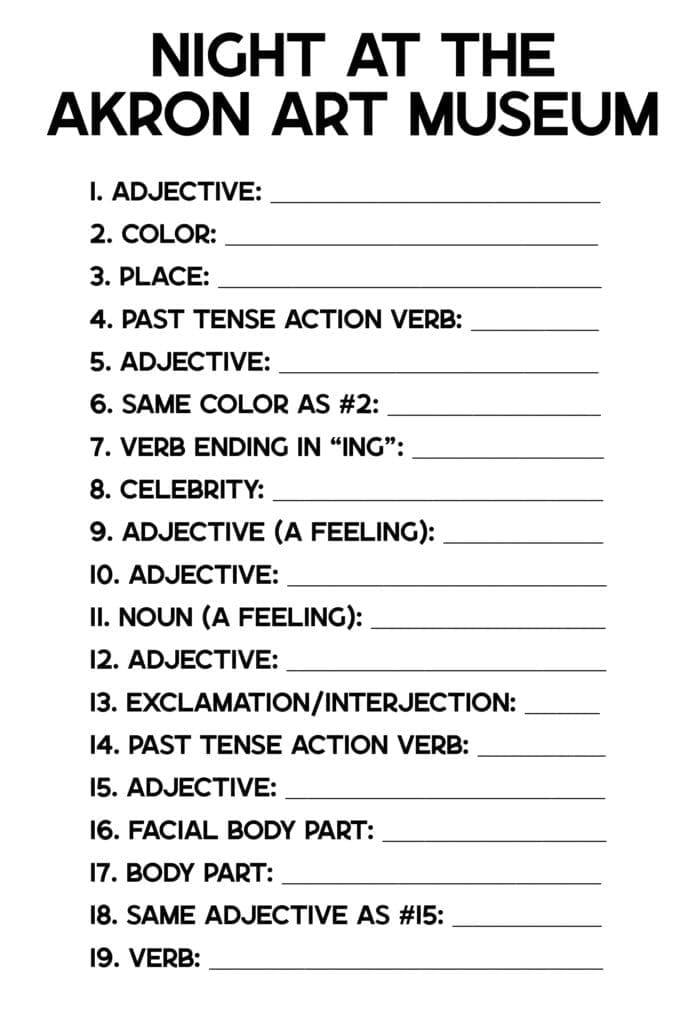
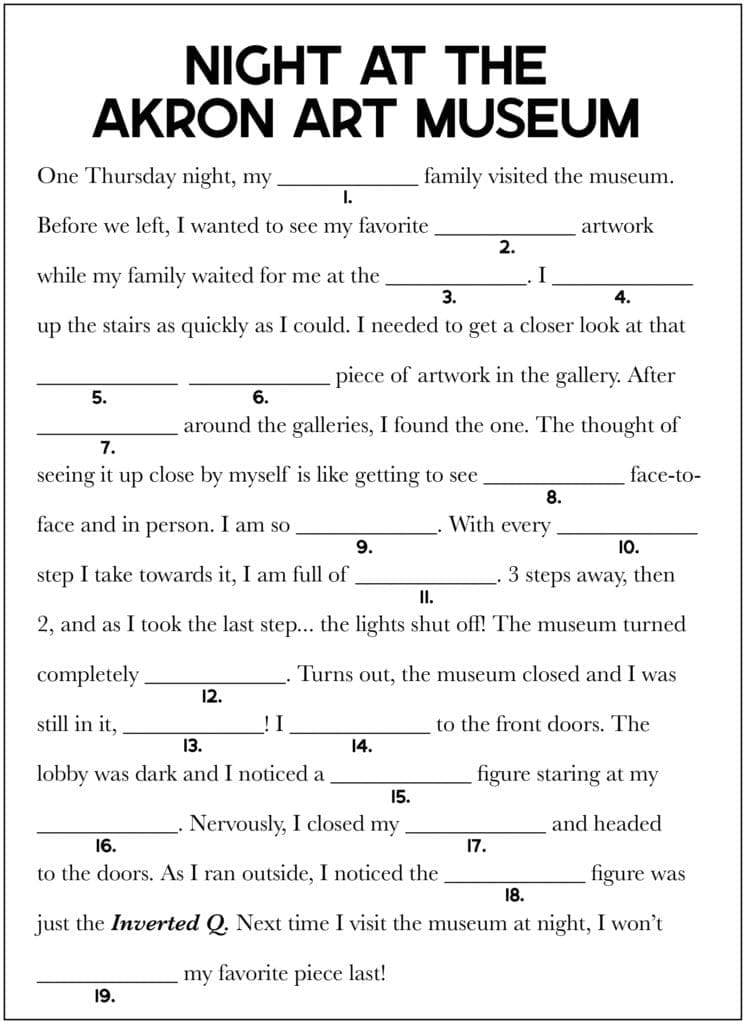
MuseumGames are made possible by PNC with additional support from Acme Fresh Market, the Kathy Moses Salem Philanthropic Fund of the Akron Community Foundation, The R.C. Musson and Katharine M. Musson Charitable Foundation, the Robert O. and Annamae Orr Family Foundation, and the Charles E. and Mabel M. Ritchie Foundation

Landscape with Yellow Clouds
A longtime favorite across Northeast Ohio, William Sommer absorbed ideas from Cubism and other modern European art movements, adapting them to his distinctly Midwestern subject matter of farm scenes, landscapes, and portraits.
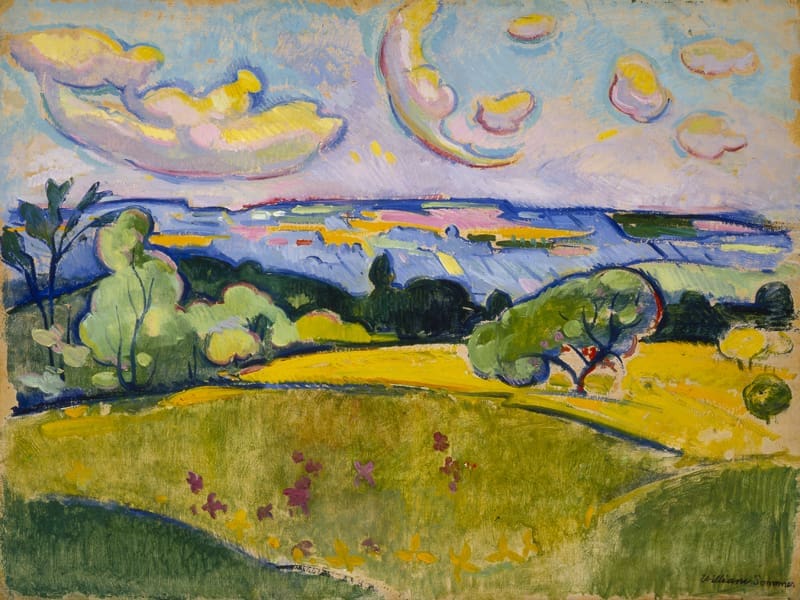
Sommer painted this landscape shortly after he visited New York City for the groundbreaking Armory Show of modern art in 1913. It was there that he saw innovative works by artists like Paul Cézanne and Vincent van Gogh. He was especially enthralled by the work of French painter Henri Matisse, whose bold and unnatural use of color shocked critics so much that they called Matisse and his colleagues “fauves” (French for “wild beasts”). This untamed use of color can be seen in the pastel blues, pinks, yellows, and greens of Sommer’s cheerful Landscape with Yellow Clouds.
Have you ever seen a sky or landscape with the colors that Sommer used for his painting? Why do you think these colors were so shocking to audiences back in the early 1900s?
Sommer spent most of his life in Northeast Ohio and was known as a leader of the “Cleveland School,” a group of Cleveland-based artists who were active during the first half of the twentieth century. As part of this scene, Sommer co-founded the Kokoon Arts Club in 1911 as an independent group designed to promote modernist art in Northeast Ohio, and to offer more creative freedom to practicing artists. Sommer’s work can also be found in the many murals he painted for buildings throughout the area, including the Cleveland Public Library, Cleveland Public Auditorium, and the main office of the Akron Board of Education.
Read MoreFamily Day: Dog Days of Summer
Summer is coming to an end. It’s a time to relish freedom, enjoy family, and spend a few more minutes in the outdoors. This month’s projects celebrate the end of the holidays.
Project 1: Lanterns, Lanterns, Lanterns
With Summer holidays coming to an end, its the perfect time to catch a few evenings as a family (and maybe a few fireflies). Lanterns can make these evenings even more magical.
What do you need? The PDF below offers three versions of lantern projects. Ideally, you’ll need a form, a translucent paper, and glue or tape.
Try this? Lanterns are easy to make. Start by creating your form. An oatmeal container works great or you can also hot glue popsicle sticks together. Even a few bent pipe cleaners can work. Adorn your form with translucent materials, like tissue paper or cellophane. A careful adult could place a tea light in the lantern, but a battery-operated light is best.
Collection Connections:

You can think of your lanterns as colorful sculptures. One particular sculpture can serve as inspiration. Lucky Bellevue’s Happy is made from pipe cleaners, as well as trays and brackets.
- What do you think the name means?
- How do you think the artist made the sculpture?
- How many pipe cleaners did he use?
- What is the title of your lantern sculpture?

Glass is a particularly good inspiration for lantern making too. Art glass can feel magical with its colorful translucency. Some artists, like Paul Stankard, employ glass to create fascinatingly realistic works. Many glass artists, like Stanislav Libensky, use glass in an abstract manner. Explore the glass objects in the collection as inspiration for your lanterns.
Project 2: Animal Collages
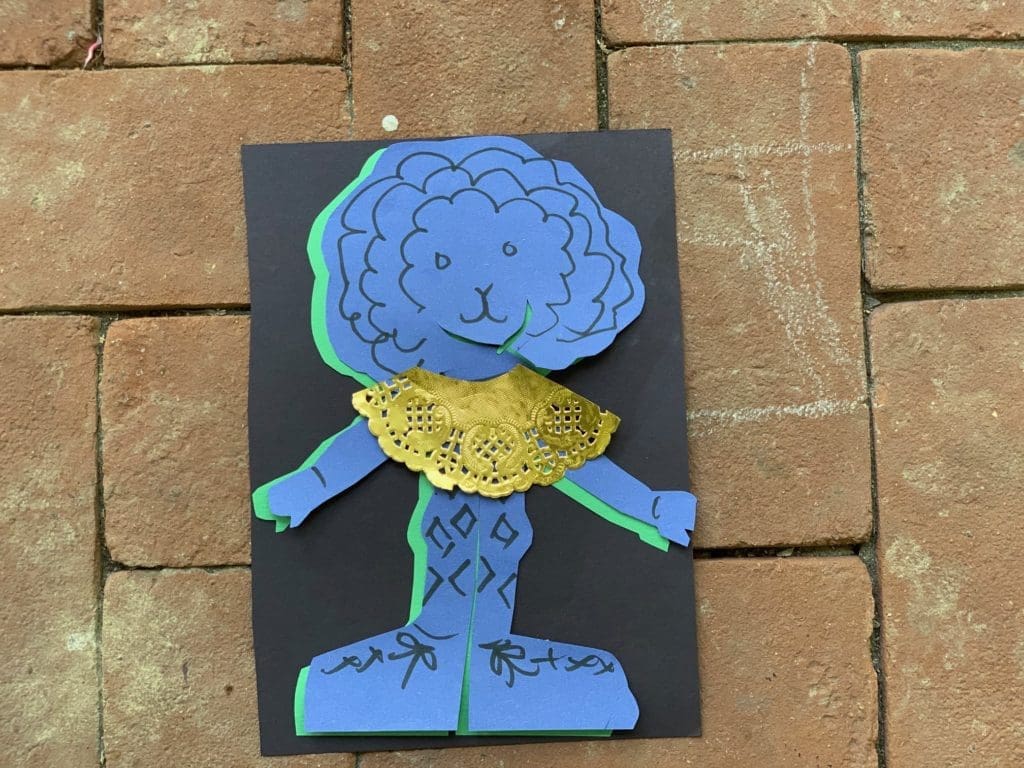
This summer, many of us spent more time at home, perhaps surrounded by pets, watching fantastical animals, or reading about out of this world creatures.
While drawing is one way to depict creatures, collage or sculpture can expand your creativity.

What do you need? Scissors, glue, paper, and/or cardboard.
Try this? Cut shapes from paper and/or cardboard. Challenge yourself to create an abstracted figure from these pieces. Glue your shapes onto a background. You can add a few details with marker at the end.
Collection Collection:

Explore Bull Connor’s Dog by Don Drumm.
- How would you describe the attitude of Akron artist Don Drumm’s dog? Despite being abstract, most people can describe the dog’s attitude.
- In what ways is this sculpture similar to a live dog?
- How is it different?
- What are some of the shapes you see in the sculpture?

Printmakers are particularly good at simplifying real life to create appealing compositions. Cyrk by Hubert Hilscher, for example, shows an animal. While it is not a photograph, most viewers would say this is a lion. Explore the ways the artist uses simple shapes to create the animal. How would you describe the animal’s attitude? Explore the other works by Hilscher in the collection. Which animal is your favorite?
Project 3: Sculpture
School is upon us, and with it, the requirements to follow the rules. Art is a chance to make your own rules. Challenge yourself to turn regular household materials into a sculpture. Make something you find beautiful.
What do you need? Pick just one media, like a plastic folder.
Try this? Use your imagination to manipulate it to create a 3-D form. Or, put together only two forms, like paper straws and pipe cleaners. As you work, think about how your sculpture looks from all angles. Pick up your sculpture so you look at the forms from a different angle.
Collection Connections:

Yayoi Kusama’s Arm Chair is made from simple materials like canvas, shoes, and an armchair. With the lack of coloration, the eye can’t help but get lost in the forms.
Explore the collection online for other sculptures. Notice how many sculptures veer towards abstraction and away from realism. What forms do you notice? What are some words you’d use to describe the surface of the sculptures?
Project 4: Break the Rules with Color
Another way to break the rules is to expand the concept of painting. You may think paintbrushes are only one way to paint. Explore what other tools from your kit can be used to apply paint. The surface you paint on can be transformed with foil or tissue paper. Or you can make a translucent masterpiece by painting on the clear vinyl.
What do you need? Compile as many non-paintbrush tools as you can. Add paper, watercolors, and water. You can also compile as many non-paper surfaces to paint on. Add brushes, watercolors, and water.
Try this? Painting without a brush can help you explore abstract painting. You can get a better feel for pattern and texture.
Collection Collections:

2009.30.6
Abstract painting is one of the strengths of the museum’s collection. Charles Cough’s Muniment, for example, offers the viewer form and color. Explore the work. Imagine applying the brushstrokes. Try to picture laying on the paint. Compare this work with the other Cough painting in the museum’s collection, July Thirteenth (70). Which painting appeals to you more? With such wide variety of abstract paintings, finding your favorites is important.
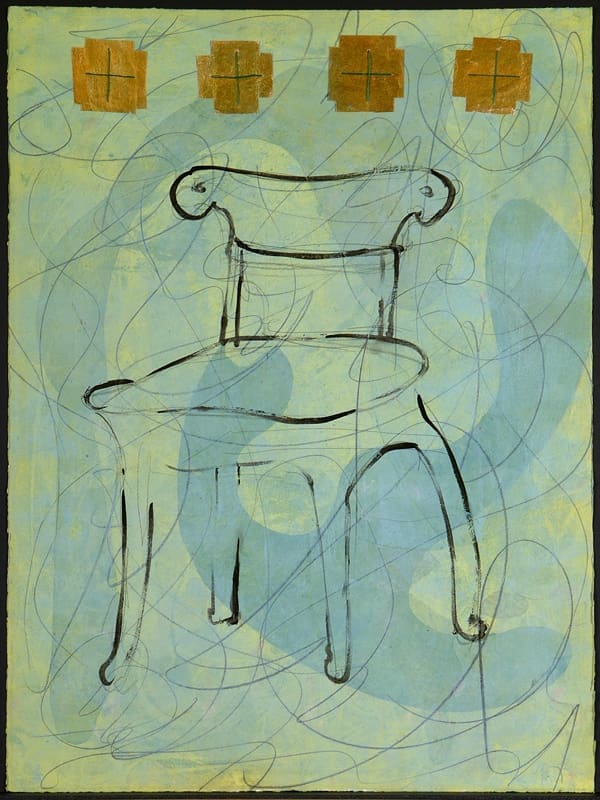
Hui-Chu Ying, (Taipei, Taiwan, 1956 – ). Invitation, 2002-203. Purchased with funds from Akron Art Museum Docents in memory of Betty Blair
2005.13
Layering color is also common in contemporary prints. Local Akron printmaker Hui-Chu Ying often layers colors. Her works include layers of color interspersed with realistic elements. You can rework your abstract bubblewrap print, for example, employing collaged realistic elements.
Collection Connections
Artist La Wilson broke many of the commonly accepted art world rules. She was largely self-trained. Rather than carving from wood or stone, her sculptures were usually assembled from found objects. Learn more:
Many of us have been home more often, passing the time differently than other summer holidays. Be inspired by La Wilson to commemorate your summer.
Get Art: Why does some art not look like anything?
Many of these projects encouraged you to create compositions you enjoy but don’t represent something you see in real life. Think about why some artists make work that is non-representational.
These projects employ supplies collected in the museum’s Creativity Care Kits. These kits are freely available, while supplies last, at the museum. Free tickets required to enter the museum.
Family Days are made possible by PNC with additional support from The Kathy Moses Salem Philanthropic Fund of the Akron Community Foundation, The R.C. Musson and Katharine M. Musson Charitable Foundation, and the Robert O. and Annamae Orr Family Foundation.

Cooking with the Collection: Patrick Nagatani
This regular series uses the Akron Art Museum’s collection as a source of inspiration for meals to cook at home. Links to recipes at the end of the post.
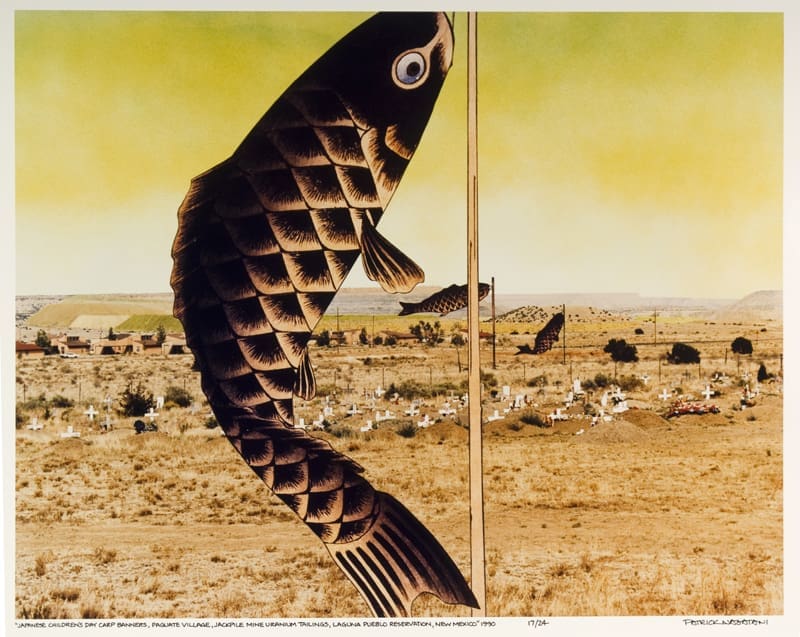
Patrick Nagatani created works that explore political, cultural and historical themes such as the Japanese American WWII incarceration experience and the legacy of the nuclear bombings of Japan. He built and staged photo-dramas to capture the stories.
His parents, John & Diane, were imprisoned in different camps during WWII, relocated to Chicago, met, married, and started a family. Patrick was born in August 1945, days after the bombings in Nagasaki & Hiroshima, and raised Catholic in a Polish Midwest neighborhood.
While a graduate student at UCLA in the 1970s, Nagatani collaborated on an exhibition and book, juxtaposing the work of two photographers who recorded Manzanar Internment Camp during WWII: Ansel Adams and Toyo Miyatake.
In 1993, Nagatani traveled to Manzanar, where his mother had been incarcerated, making a photographic survey of memorials, remnants of habitation, and the landscape.
Hidden Kitchens (NPR.org) recorded Japanese-Americans: Ms. AKEMI TAMARIBUCHI: I’m 3rd generation Japanese-American. During WWII, my family was interned. I’m positive that many of the dishes I grew up eating stemmed from what they had in camp. Weenie Royale is one of my favorites. Sunday mornings, we always had sliced hotdogs mixed with eggs with soy sauce, stir-fried with onions over rice. There are so many things that have affected our culture, like the food. Some of my closest friends, never even heard the fact that the Japanese were interned…
As a docent at Akron Art Museum, cultural research is step one when creating tours. Honestly, I don’t remember hearing about Japanese internment during American History class, but I did learn about Manzanar watching The Karate Kid (1984). My heart broke then for Mr Miyagi’s loss & breaks now listening to voices of Japanese-Americans recalling their experiences — realizing that we must share hard truths with future generations.
…Ms. TAMARIBUCHI: To be honest, I think the Japanese culture is very silent. Nobody ever complains or talks about any bad times. My grandmother, my obachan, now 85, has become far more sensitive, wanting all of her family to understand where everything came from. Call the grandkids when obachan makes Weenie Royale for breakfast. Come and spend time so that you learn how to make this food, so you can make it for your children and their children.
Weenie Royale à la Patrick Nagatani
Ingredients
1/2 white or yellow onion – chopped
1 tbsp soy sauce
2 hot dogs – julienne sliced
3 eggs – beaten
cooked white rice
Instructions
1. sauté onions in soy sauce – medium heat – caramelize
2. add hot dogs – cook 2–3 minutes
3. add beaten eggs – cook until eggs are done
4. serve over rice
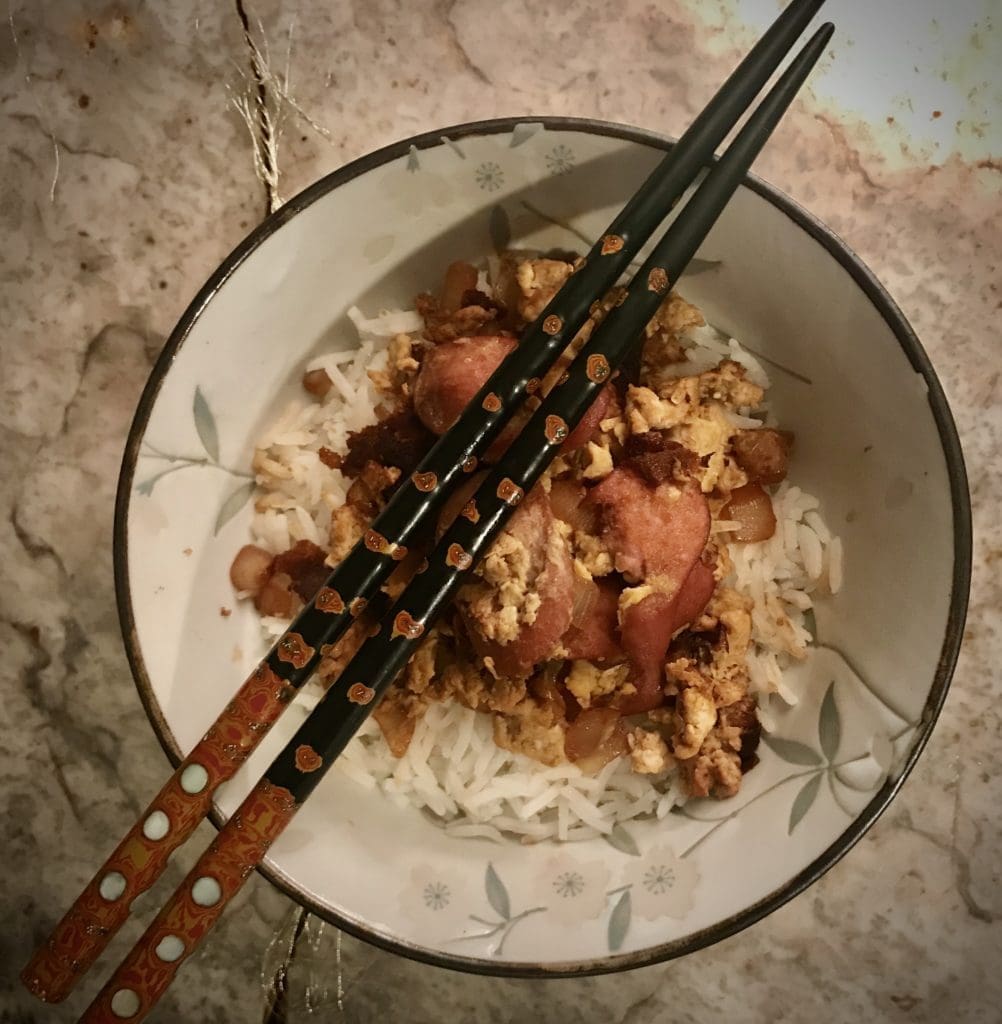
Cooking with the Collection is made possible with support from Acme Fresh Market, the Henry V. and Frances W. Christenson Foundation, and the Samuel Reese Willis Foundation.
Read MoreAnd Southward Dreams The Sea
Charles H. Davis
“The hills look over on the South, / And southward dreams the sea; / And with the sea-breeze hand in hand / Came innocence and she.” This fragment from Francis Thompson’s poem “Daisy” inspired Charles H. Davis as he watched clouds float over Long Island Sound, past his home in Mystic, Connecticut.
Davis studied this particular stretch of sky for nearly forty years, having moved to Mystic specifically because of its picturesque landscapes.
In this painting his lasting and thorough attentiveness paid off with clouds that are not simply white, but also gray, blue and violet as sunlight streams through them. Like the woman who provoked Francis Thompson’s poem, Davis’s clouds are full of gentle personality and seem to move “with the sea-breeze hand in hand.”
Do you have a place where you spend time over and over again, so that you know it in complete detail? What makes that place special to you?
Read MoreCooking with the Collection: Claes Oldenburg
This regular series uses the Akron Art Museum’s collection as a source of inspiration for meals to cook at home. Links to recipes at the end of the post.

Akron’s former role as a center for rubber manufacturing inspired Claes Oldenburg’s Inverted Q, but it is to Mary & Louis Myers that the work owes it existence. In 1972 they invited Oldenburg to Akron & asked him to propose a sculpture for a park adjoining the downtown library. A fan of Goodyear’s giant balloons in Macy’s Thanksgiving Day Parade in New York, Oldenburg was thrilled to collaborate with the rubber companies. Two years later, researchers & technicians at the rubber companies revealed that current technology did not permit the casting of such a massive form in rubber. In 1976, Oldenburg had Inverted Q cast in concrete. Inverted Q, based on the city’s history, has been one of the best-loved works in the museum’s collection.
You are a 4th grade student on a field trip at Akron Art Museum on a blustery grey, northeast Ohio day. Sitting on the warmed concrete floors amongst classmates, with angular steel & glass soaring overhead, a docent welcomes your group with reminders to walk & not run, look & not touch, share in the discussion, but raise your hand & do so quietly. She invites everyone to discover that your group has the museum to itself, as the doors are locked to the public at this early hour. Hmmm, what else is there to learn in a modern & contemporary art museum…
Hi! I’m Miss Maryann, and I am your docent today. A docent is an art museum teacher. Now, I know that you know all the rules, but we are going to explore the museum with all 5 senses today! What are the 5 senses? smell . sound . sight . touch . taste . “How are we going to look & not touch”, you ask? And what could we possibly taste?

Are you ready to TASTE a concrete sculpture?
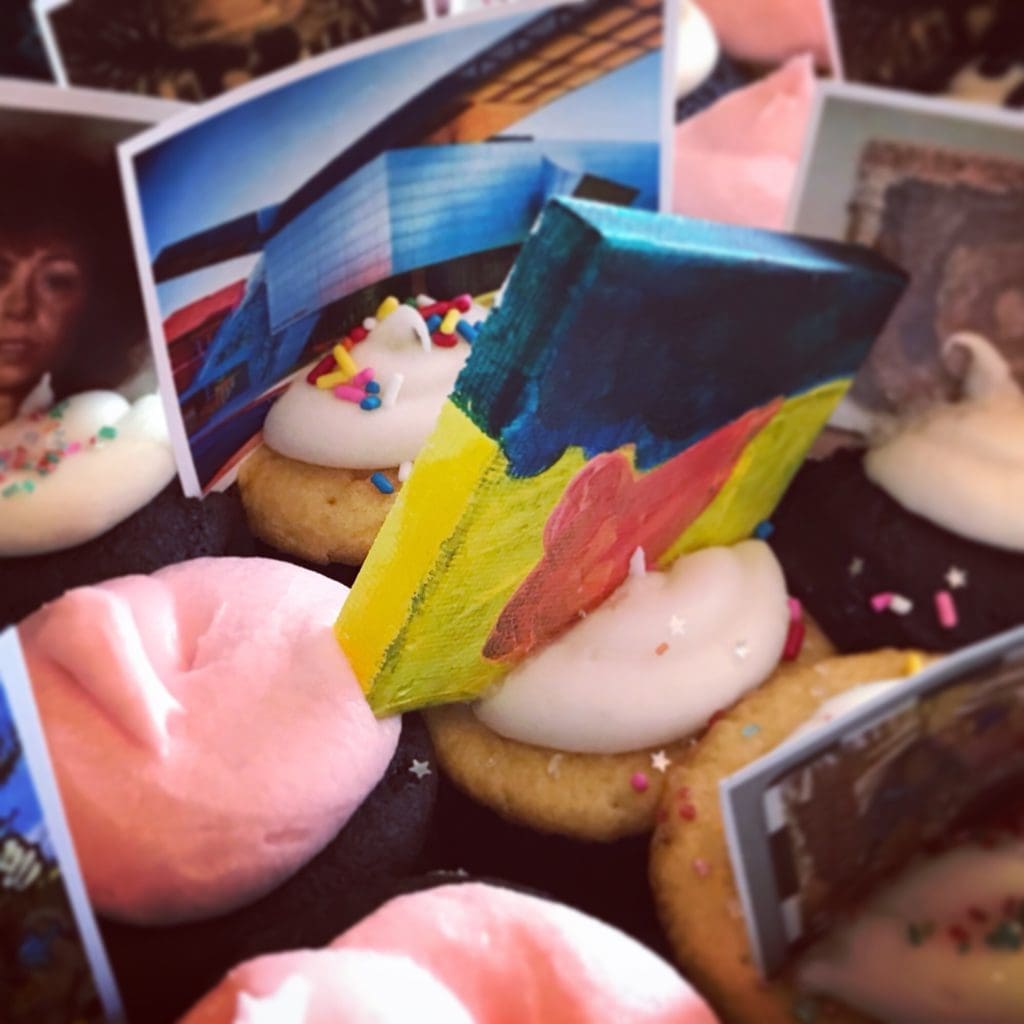
Claes Oldenburg’s Strawberry Buttercream
Before my students know the title, author, or details of an artwork, we begin the exploration using our imagination. With awe they usually gather around Inverted Q and ask, “What is it?” and I reply, “What do you think it is?” After a silly discussion of what the sculpture looks like to them I ask, “What do you think Inverted Q would taste like?”
INGREDIENTS
1 boxed cake mix prepared as 18 cupcakes
it’s okay to cheat on this one with a box mix the frosting is the star of the show for the buttercream frosting
3 cups powdered sugar
1/3 cup butter – softened
1 1/2 tsp strawberry extract
1–2 tbls milk
INSTRUCTIONS
1. mix powdered sugar & butter in a medium bowl (hand or stand mixer)
2. stir in strawberry & milk
3. fill a large ziploc-style bag with buttercream -cut off 1 corner tip
4. pipe an inverted Q onto each cupcake
Oldenburg wanted the sculpture to appear soft, inflated, & light, although it would be heavy. This buttercream is certainly soft & light, though rich & buttery.
Cooking with the Collection is made possible with support from Acme Fresh Market, the Henry V. and Frances W. Christenson Foundation, and the Samuel Reese Willis Foundation.
Read MoreRetrospective, La Wilson
In museums, a “retrospective” is an exhibition that represents an artist’s entire career from its start to the present. Here, La Wilson provides a personal retrospective all in one piece of art.
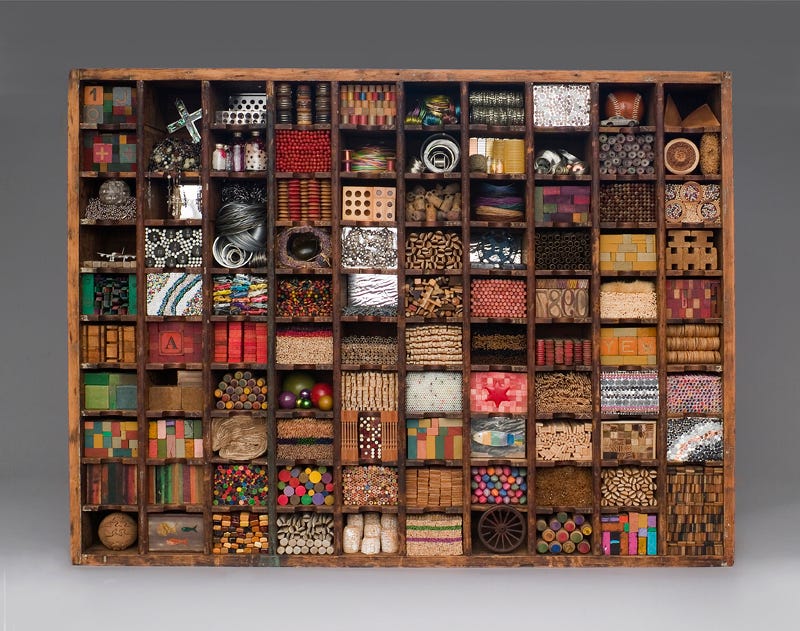
Wilson’s largest and most complex assemblage, Retrospective summarizes and celebrates the many different types of objects that she incorporated into her work over the course of more than fifty years.
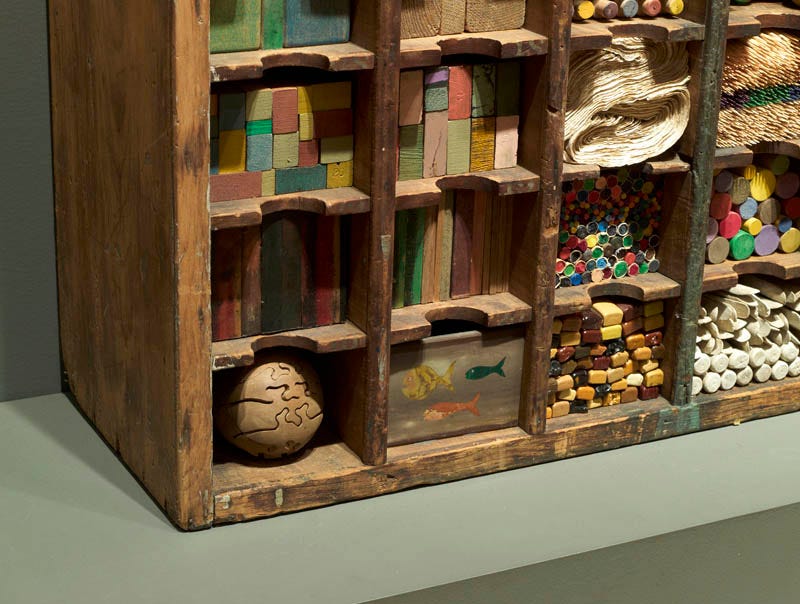
Wilson described her artistic process this way: “First I collect — anything that appeals, for whatever reasons. Then I start putting things together, usually in a box and what often happens is that these everyday mundane things change their essential nature when [combined] in unexpected ways with other material.”
Under normal conditions its pencils, dominoes, wooden blocks, beads, spools of thread, and other objects would seem commonplace and unimpressive. Placed all together, they take on a new kind of beauty and suggest that excitement can be found in everyday things if one looks closely enough.
When you look across Wilson’s Retrospective, does it seem more like a collection of lots of little objects or like one big picture? Which kind of looking do you think the artist preferred? Do you think it has to be one or the other?
Read MoreCooking with the Collection: Pablo Picasso’s Herb Soup
This regular series uses the Akron Art Museum’s collection as a source of inspiration for meals to cook at home. Links to recipes at the end of the post.
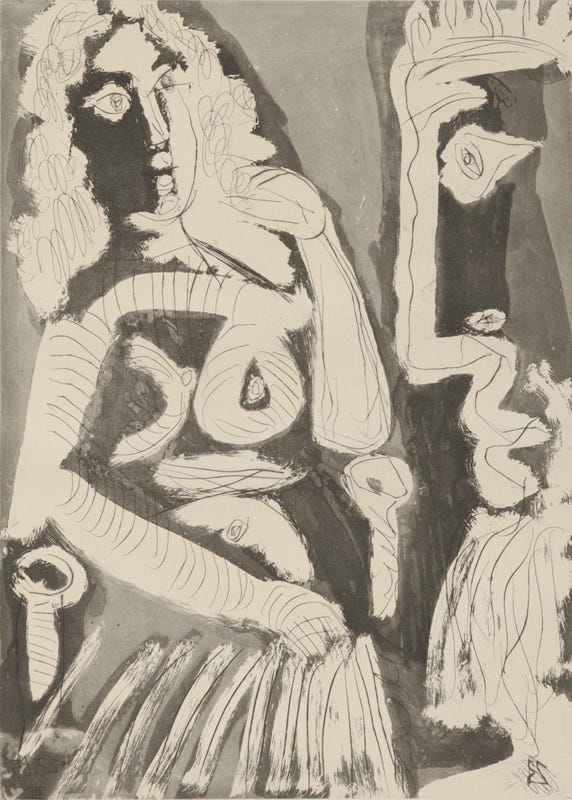
Pablo Picasso met Jacqueline Roque in 1953 at Madoura Pottery in Vallauris, Southern France, when she was 26 years old and he was 72. Jacqueline’s image began to appear in Picasso’s paintings and is characterized by an exaggerated neck & feline face, distortions of her features. Eventually, her dark eyes and eyebrows, high cheekbones, and classical profile would become familiar symbols in his late paintings. In 1963 he painted her portrait 160x and continued to, in increasingly abstracted forms, until 1972.
The printmaking process Picasso used to create this portrait is called aquatint because finished prints often resemble watercolor drawings or wash drawings. The process achieves a broad range of tonal values — the light or dark of a color — which is the most important design element of a painting. The drypoint line drawings are reminiscent of Picasso’s uniform of his later years, the Breton striped shirt.
As a docent & studio art educator at Akron Art Museum, you’ll see hints of my favorite black & white stripey shirts in-studio lesson photographs. The iconic style was a staple in the wardrobes of other creatives like F. Scott Fitzgerald & James Dean. The Breton shirt was created officially by French law in 1858 for their Navy. The contrasting stripes made any sailor who fell overboard easier to spot in the waves.
Are you ready to fall overboard for soup?
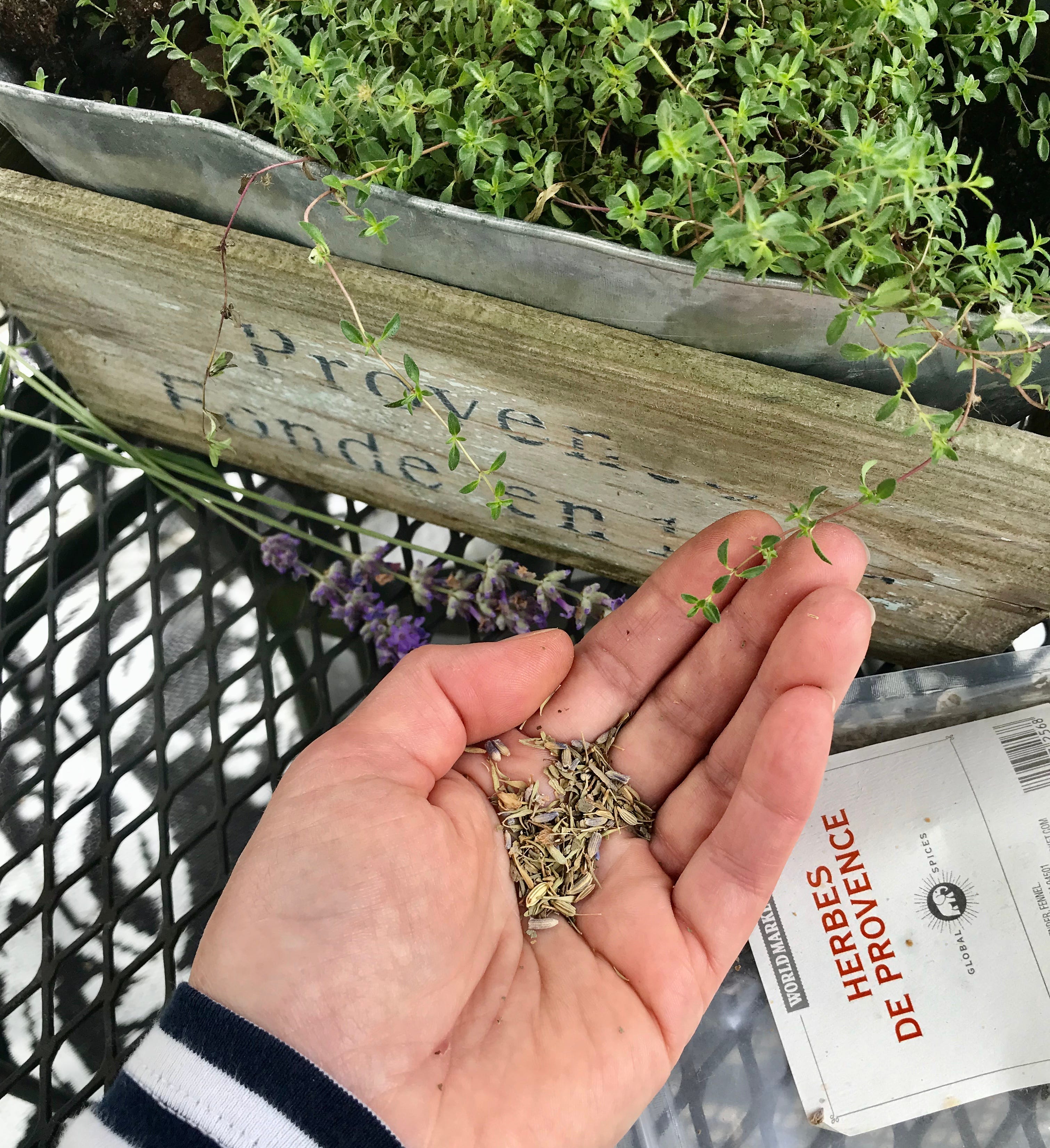
Pablo Picasso’s Herb Soup
This recipe is about to carry you from the South of France to heaven on waves of tasty tonal values. Lentils & mushrooms simmered in white wine, create a flavorful, earthy broth, while salty olives & capers lift your tastebuds, taking off on sweet, stewed tomatoes …until fragrant herbes de Provence carry you away with the clouds on a lazy, summer day. herbes de Provence thyme. savory. oregano. marjoram. rosemary. lavender.
INGREDIENTS
3 tbls EVOO – divided
1 small onion – diced
3 garlic cloves – minced
3 cups water
1 cup dried French green (or brown) lentils
1 1/2 tsp herbes de Provence
8 oz cremini mushrooms – sliced
1/2 cup dry white wine
14 oz can diced tomatoes
3 tbls tomato paste
1/2 cup olives
2 tbls capers
S&P
INSTRUCTIONS
1. 1 tbls EVOO in medium pot. medium heat
2. add onion. sauté 5 minutes
3. add garlic. sauté 1 minute
4. add water, lentils, & herbes de Provence. bring to boil
5. lower heat. cover. simmer 30–35 minutes
while lentils are simmering…
6. 2 tbls EVOO in a sauté pan. medium heat
7. add mushrooms. even layer. sauté each side 5 minutes.
remove to plate
…back to the soup
8. add wine to the pot. raise heat to simmer. cook 4 minutes
9. add mushrooms, tomatoes, tomato paste, olives, & capers to the pot
10. simmer soup 5–10 minutes. season with S&P
serves 4
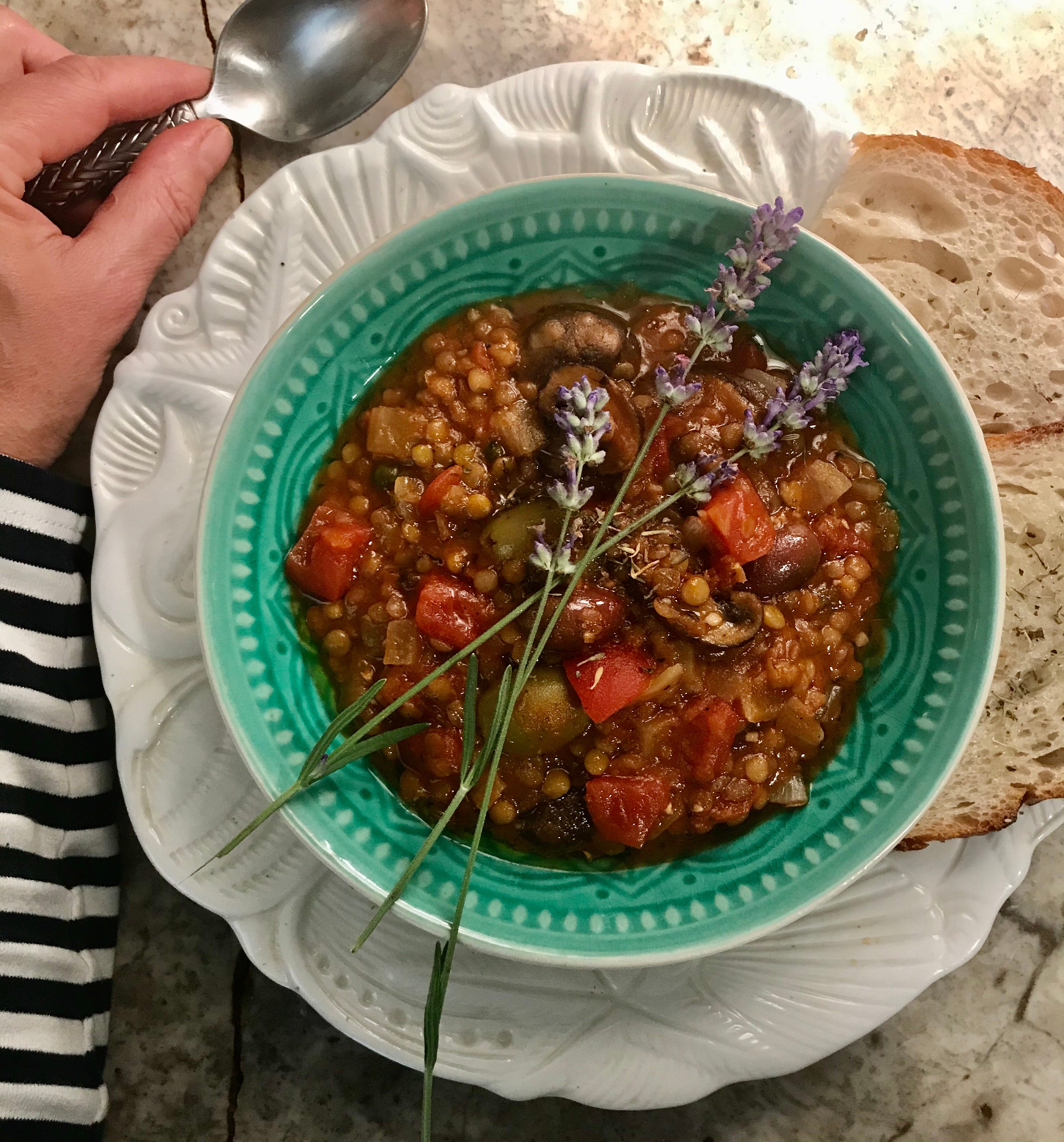
Cooking with the Collection is made possible with support from Acme Fresh Market, the Henry V. and Frances W. Christenson Foundation, and the Samuel Reese Willis Foundation.
Read More

